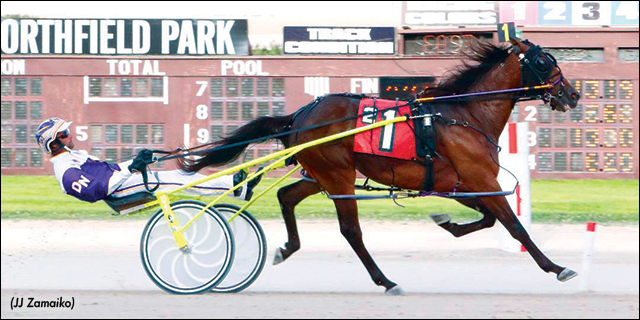When Ocean Rock paced to a new world record clocking of 1:51.1 on Aug. 24 at Northfield Park in his $40,000 Ohio Sires Stakes division, Lyndsay Hagemeyer had tears in her eyes.
The son of Rockin Amadeus, who established a new mark for two-year-old pacing geldings on a half-mile track, heads up a field of eight in the $300,000 Ohio Sires Stakes final (race 10) on Sept. 1 at Northfield Park. Danny Noble trains and drives the youngster for longtime Standardbred owner Sandra Burnett of Wilmington, Ohio, from post six.
Hagemeyer, a third-year veterinarian student at The Ohio State University College of Veterinary Medicine, was on the scene when Ocean Rock first entered this world at the Hagemeyer family farm in Clarksville, Ohio.
This speedy youngster, the first foal out of the On The Attack mare Ocean Pearl, p, 5, 1:53.2f ($143,637), has $78,167 in career earnings coming into the final.

World record holder Ocean Rock overcame long odds to make the races, let alone Saturday's $300,000 Ohio Sires Stakes final at Northfield Park.
“He was a ‘dummy’ foal,” Hagemeyer recalled. “He didn’t want to get up on his own and he didn’t appear responsive to his mother. It was a normal delivery, and while we’re always on hand if a mare needs assistance, we didn’t have to intervene with his delivery. But after he was out and getting cleaned off, we realized his situation quickly.”
The term ‘dummy foal’ is a common moniker in the breeding business. The official term is “neonatal maladjustment syndrome.” Dummy foals often appear confused, detached and unresponsive to their dams and many require round-the-clock care and feeding by breeders.
“The theories on what causes this condition varies,” Lyndsay stressed. “Some veterinarians think it could be a result of an overabundance of neuro-steroids in a foal’s bloodstream, which help to keep them quiet during the birthing process, or a slight lack of oxygen during delivery — nobody is really sure. The average is about three out of every 30 foals will be dummy foals.”
To assist the newborn Ocean Rock, Hagemeyer, working in tandem with her parents, Scott and Cindy Hagemeyer, performed what is known as the “Madigan foal squeeze” procedure on the newborn.
The foal is wrapped gently with soft ropes, in a kind of mini-harness, and light pressure is applied for a short period to mimic the time the foal is in the birthing canal.
“The purpose of squeezing is to pursue the foal’s brain to go from neuro-inhibition to neuro-activation,” Hagemeyer explained. “In other words, to make them wake up from the womb.”
After about 20 minutes, the ropes are removed and the foal gets up, suddenly alert and responsive and interesting in nursing. The technique is named for the University of California-Davis veterinary professor James Madigan, an expert in equine neonatal health.
“We got him up every hour, and then less frequently as he became more able to get around on his own,” Hagemeyer related. “We also supplemented him with colostrum and a plasma infusion. The main issue was making sure he got his colostrum as the mare had low levels of it.”
Colostrum is fluid produced by a mare prior to her milk production and is loaded with antibodies necessary to boost a newborn foal’s immune system. The mare produces colostrum no more than 24 hours prior to birth and is vital to a foal’s survival. It is imperative that a foal get colostrum from the mare within the first two hours of its birth to fight off infection — the main cause of death in newborn foals. Often, breeders will supplement a foal when the mare’s colostrum levels are low, and many keep supplies of colostrum from donor mares on hand throughout the foaling season.
“Sandra (owner Burnett) is a close family friend and brings her mares to us to foal out and we also wean them and breed them back for her,” Hagemeyer said. “She’s the type of owner who does right by her horses. She never sells a filly and has a ton of horses at her home.
“There are days in the breeding business when you really question what you’re doing and think, ‘Why am I here?’” Hagemeyer offered. “But then, when you see a horse like Ocean Rock go out and set a world record, you know all the hard work that it took to get him here was worth it. It’s just so exciting to know where he came from and see where he is today.”
(OSDF)

